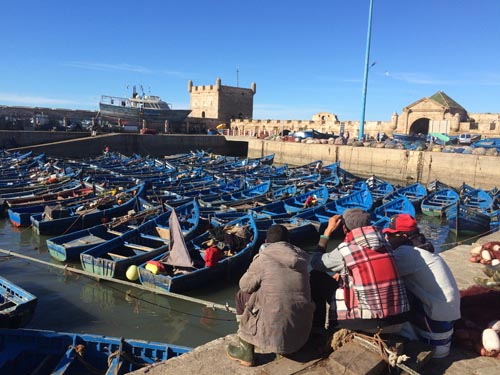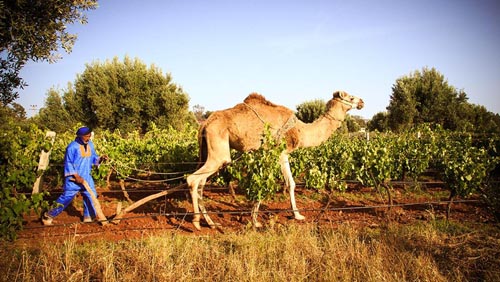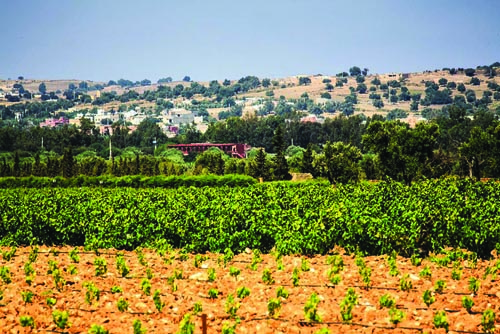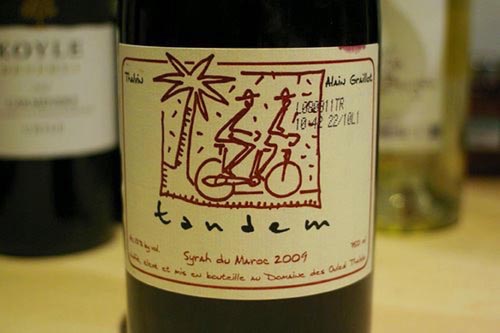The French connection: A guide to Moroccan wines
Moroccan wines take much inspiration from the Gallic, and growers are even returning to cultivate grapes in North Africa again. Roger Jones of the Harrow at Little Bedwyn discusses the unique wines of the country
Having recently returned from a wine trip to Morocco, one thing struck me as similar to the UK. It was certainly not the weather, but the spices. The aromas when walking through the bazaars reminded me of all the Christmas spices that are emitted from kitchens during the festive period.
Morocco is certainly not on the wine map for the majority of us, although in France it has a more recognised following. However, in a world where the wine industry continues to turn heads (just look how popular English
sparkling wine is now in the premium market) and brings new regions to the fore, it is an area we should not ignore.
Morocco's colonisation by both Rome and France means there is history of wine-making in the country. There is even some proof that viticulture was present here prior to Roman times. However, when France relinquished control of the colony in 1956, tens of thousands of hectares of vines lost their French expertise and consumers. Then, in the late 1960s, strict new EU regulations were brought in to protect the over-production of Italian and French wines, killing Morocco's presence in France.
The late King Hassan II fought hard in the early 1990s to bring back French influences to the vineyards, and his legacy is now building, as we see many influential French winemakers making a foray into the country, such as the Rhône's Alain Graillot and Bordeaux big-gun Bernard Magrez.
Morocco is now the second-largest wine producer in the Arab world (behind the bulk wine of Algeria) and production is mainly situated around Casablanca, Meknes and Essaouira.
Moroccan food was certainly an inspiration to me, with its combination of Eastern spices mixed with classic French ingredients, and the wines grown here are very much in the French style and variety. In particular, we are seeing Rhône varieties blossoming with great delicacy.
Due to Muslim beliefs, the majority of the local population do not consume alcohol; however, towns like Marrakesh and Essaouira are a haunt for the rich and famous, and therefore there is a demand for quality wine.
Moroccan food and wine matching
a lovely tangy, citrus element.
The reds should be treated as good basic Rhône or southern French table wines, and
are very good with hearty winter dishes such as fowl. The style of food I ate in Morocco was very refined, with a strong French influence, bringing the Arabic style to life.
Vineyard profile - Val d'Argan, Essaouira, western Morocco
This winery, set inland from the coast, is owned by Charles Melia, a Frenchman who was brought up in Morocco before returning to France to work at the family winery, Domaine Font du Loup in ChÁ¢teauneuf du Pape. In the early 1990s he decided to go out on his own and search for a new wine region. He lookedat Chile and Argentina, but settled on Morocco. Melia's daughter Anne-Charlotte now runs the family business in France.
He said that he chose the site due to its resemblance to Napa Valley, and besides the searing heat in the summer, he felt that this was a great place to plant vines. The surrounding areas are dominated by olive trees and argan trees, whose argan oil has many uses in the region. To help protect the vines, Melia has left rows of olive trees in the vineyards and introduced sorghum. He also covers the vines with branches in the extreme heat.
The range produced by Melia is quite substantial and it covers all price brackets. On my visit, the white wines reflected better - not only in quality, but also for the local food and temperature. The area is, of course, a haven for fresh fish, straight off the boats.
Gazelle de Mogador 2013 (white)
This is fresh and bright with a good balance of classical white Rhône blends. There is a lovely texture to this wine; it's full-flavoured on the outset, but with a good, clean citrus finish.
Le Val D'Argan Roussanne 2014 (white)
Bright, tangy and zesty with fresh orange blossom. The acidity is well-balanced and it is very precise - as you would expect from a 100% Roussanne.
Le Val D'Argan Orian 2012 (white)
Roussanne and Clairette Blanche grapes. Beautiful golden hue; lingering, rich and luscious with ripe pears, crisp, sweet pastry and delicate oak. It reminded me of Paul Jaboulet's Chevalier de Stérimberg. Very impressive.
Le Val D'Argan Orian 2012 (red)
A smoky flavour with sweet and savoury notes. Meaty and luscious, it has a lovely balance and a touch of pleasant farmyard on the finish. Based on 70% Syrah with Mourvèdre and Marselan (a cross between Cabernet Sauvignon and Grenache).
Regional highlights
Benslimane region
Tandem Syrah du Maroc 2011
This wine is made by Alain Graillot, an established French winemaker famous for making sublime Crozes-Hermitage. It's deep red with cigar smoke, restrained elegance and pepper. There's dark cherry and incense spice on the palate with a silky, rich finish. This is a joint venture for Alain with the Ouled Thaleb winery, and it is named Tandem in memory of his cycle holiday trip around this area, when he first met the owners.
Zenata region
Domaine des Ouled Thaleb
Cuvée Premiere 2012
Cabernet Sauvignon and Grenache. Generous and aromatic, fresh, fruity and light.
Berkane region
Domaine des Trois Cavaliers
Clos Hermitage 2011
Mostly Viognier with Grenache Blanc and Clairette. This is probably the best wine I tried in Morocco: sublime and richly textured with a delicate perfume of juicy apricots and peaches. They also produce a red called Clos Hermitage, 100% Syrah, which was not quite as good as the white, but was elegant and very subtle with gentle spices.
Meknes region
ChÁ¢teau Roslane Premier Cru,
Les Coteaux de l'Atlas 2011
A delicate and refined wine with vanilla and spices, and deep red-fruit aromas which are rich and silky. This is from Les Celliers de Meknès, established in the 1920s.It's based in the north-east, facing the Mediterranean sea, with the protection of the Atlas mountains on the other side.
ChÁ¢teau Roslane,
Les Coteaux de l'Atlas Chardonnay 2012
This wine has vanilla and toasted aromas on the nose and a soft perfume, then a bright, refreshing palate of zesty flavours and spring flowers.
Latest video from The Caterer
Continue reading
You need to be a premium member to view this. Subscribe from just 99p per week.
Already subscribed? Log In












